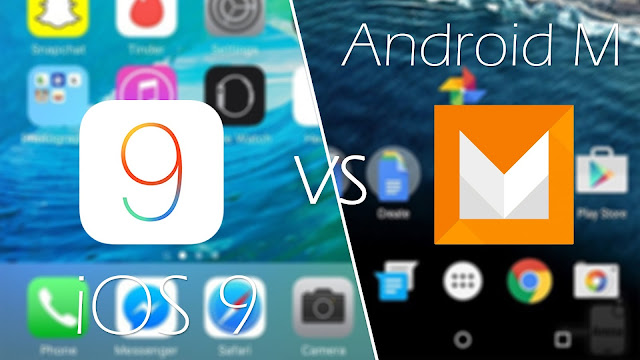Both Apple and Google have released developer previews of upcoming operating system platforms. Android M and iOS 9 will be officially launched within weeks of one another starting out in the Fall. While both Android M and iOS 9 are not complete overhaul of the platforms, rather center on shuttle improvements to improve user experience such as performance, battery management, and multitasking.
So it is about time to pit arch rivals against each other and compare some major features:
Android M vs. iOS 9 Comparison
Siri vs. Google Now:
Google Now and Siri got extensive coverage during both Google's and Apple's developer conferences. Google Now understands contextual information like never before. Now you can find out details of artist while listening to music. Simply ask “what’s his name.” Similarly you get information about nearby cafés if someone sends a text message about where you would like to have coffee without you having to say anything.
Google Now in Android M becomes “Now on Tap” which means you can long press the home button wherever you are to call up Google Now. The best part is that you don't need to navigate away from the app you're using.
Siri get more proactive than before. This seems to be a step in the right direction to curb the growing dominance of Google Now. Siri is also getting more contextual in iOS 9. For instance, if you get a call from unknown number, Siri can use relevant information on your phone and emails to suggest who that person might be.
Permissions and Privacy:
One of the major changes in Android M is the changes in permission levels. Now you don’t have to provide zillions of permissions to apps during the installation process. Rather permission will be requested as and when needed.
Now Apple tracks your phone usage and sends algorithms through your emails to optimize some of Siri's new features. However, the data gathered is strictly stored 'on-device' and remains private and works for your own benefit.
Apple Pay vs. Android Pay: Mobile Payments:
While Google was an early player in the mobile payments, it is yet to taste success in this field. Google Wallet will be rebranded and launched as Android Pay. Just like Google Wallet, Android Pay will use NFC to allow customers make mobile payments in 700,000 locations across the United States. The Apple Pay developments at Apple’s WWDC 2015 was more about expanding into new markets.
Android M vs. iOS 9: Battery:
Android devices have been known for dubious battery life. With Android M, the focus shifts on new feature called Doze. This new feature attempts to optimize battery life by lowering apps' background activity when phone is in standby mode dramatically.
Battery life was never a trouble area for Apple. Still the tech giant announced a 'low power' mode in iOS 9 that would boost battery life by an extra three hours. Apple also said that standard battery life in iOS 9 would improve by an hour.
Finally
Both iOS and Android are different operating systems. It is more like comparing Apples and Oranges. Yet with each and every upgrade two different operating systems are becoming similar, picking the best features. Google is trying to emulate the success of Apple Pay with the launch of Android Pay. Similarly, Apple is trying to ensure that its virtual assistant Siri gets more proactive and contextual, like Google Now.
Lollipop and iOS 8 were complete transformation. But they brought with them tons of problem. On the other hand, iOS 9 and Android M don’t bring about paradigm shift; rather focus on small changes for big impact.
